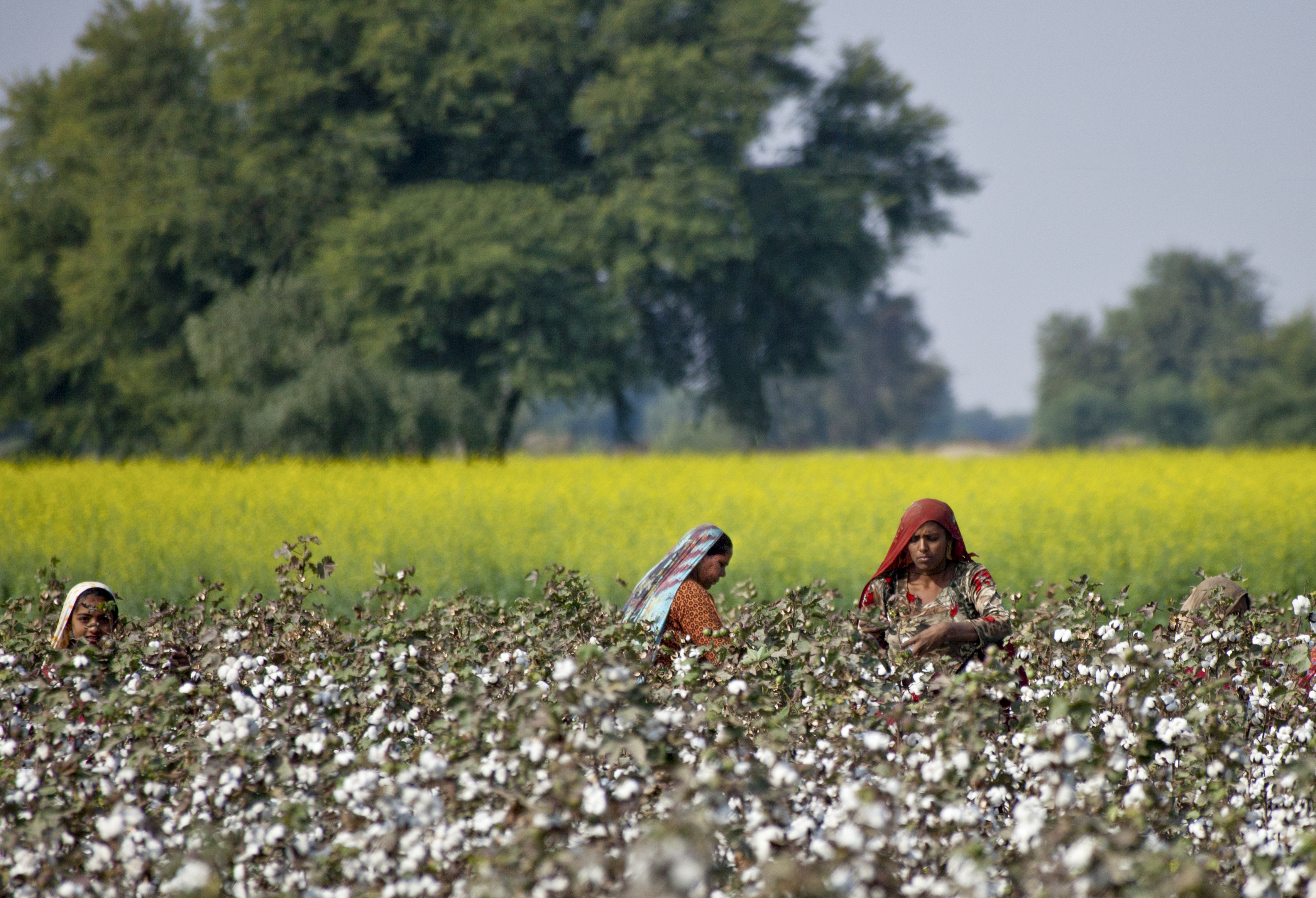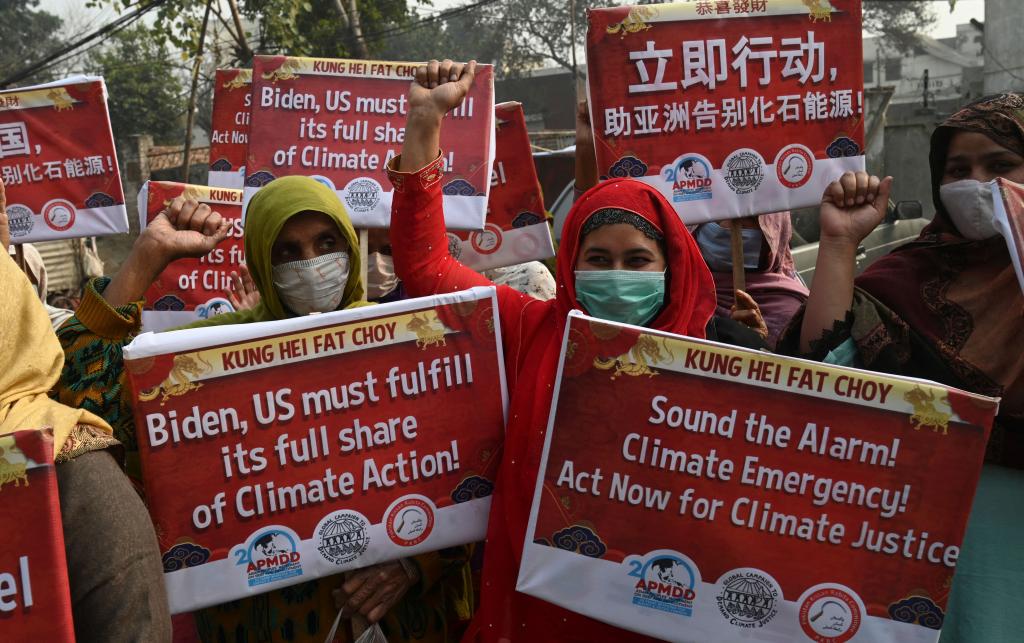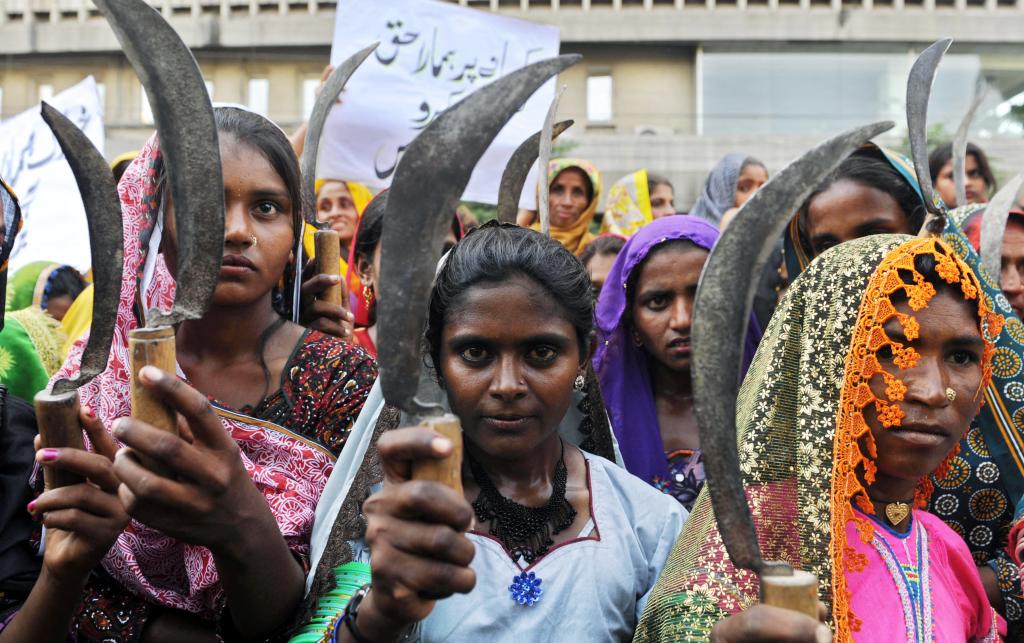— Pakistan: land struggles, by Ayesha Ahmad

by Ayesha Ahmad
Ayesha Ahmad has been teaching at public and private sector universities for 15 years, and is currently teaching Politics at Universal College Lahore (UCL). She is a freelance researcher, and a trainer on labour rights and gender equality
The marriage of cotton and South Asia dates back to 6000 BC. The great Indus Valley Civilization spread from modern-day northeast Afghanistan to Pakistan and northwest India, and it is here that cotton was spun for the first time. Mehergarh, or modern-day Pakistan, was an arid plain where the discovery of mineralised cotton fibre and the cultivation of a cotton crop saw women take pride in draping themselves in untailored mul, a handloomed cotton fabric – long before colonisation transformed the Indigenous fashion industry of the Global East. The production of this crop set forth the foundations of a textile journey that continues to shape the modern world.
It was once boasted that the ‘sun never sets on the British empire’ – a statement that hid greed, conquest and generational cultural trauma. Under the apparent narrative of ‘torch bearers’ civilising the globe, the British empire erased Indigenous orientations, shaped the trajectory of the land it occupied by exploiting economies, changed the course of rivers and turned the most fertile land into pillars of concrete, bringing about irreversible climate damage. All to establish a cotton empire for a future textile industry that would benefit the Global North for centuries to come.
The East India Company in the early 17th century set its eyes on Bombay and Bengal. The era of white dominance and exploitation embedded itself into a system where labour, land, resources and control were all in the hands of the ‘mighty white,’ establishing the foundation of exploitation in the name of trade. Textiles are intrinsically rooted in the Global South being colonised as a factory land for the Global North. Clothing, in its essence, has been contaminated by colonisation.
Today, Pakistan is the world’s fifth-largest producer of cotton, exporting US$3.4 billion worth of cotton in 2021 and making up roughly 6% of the global supply.115
In January 2023, the Pakistan Bureau of Statistics listed textiles, including cotton, as accounting for 60.82% of Pakistan’s total exports, with a value of US$19.33 billion.116
Land struggle and its direct effect on the cotton crop and the garment and textile industry needs to be looked at through a lens of gender, colonisation, military rule, and other linked issues such as water supply, dam construction and urban housing schemes. This shows how the question of land does not begin and end at land itself but is deeply entrenched in power hierarchies.
Cotton and climate
Ten million Pakistani farming families are reliant upon cotton production,117
leading to turmoil and hardship when 45% of Pakistan’s cotton crop was washed away in the devastating climate-breakdown floods of 2022.
The floods, which followed an intense heatwave, affected a third of the land mass, killing more than 1,700 people and destroying or damaging 2.2 million homes. The floods affected 33 million people and damaged most of the water systems in flooded areas, forcing more than 5.4 million people to rely on contaminated water from ponds and wells.118
Increasing environmental pressure coupled with political turmoil is leading to a growing number of farm family members choosing to quit the farming profession. Young people in particular are leaving farming due to poverty, financial challenges, urbanisation and the physical and psychological struggle to repay debts. Once they have left the industry, many end up as labourers in the garment industry.119
Land grabs
Farmers are also being driven from their heritage-like affiliation to their ancestral profession by present-day colonialism carried out by urban land mafias. In the port city of Gwadar, Baluchistan, and the Thar Desert in Sindh, huge international development projects promised better futures for local communities, but in reality have caused the disturbance of natural habitats, mass migration, dispossession and health issues. In Gwadar for example, international capital promised to revamp the city’s infrastructure and bring it up to par with other global port cities, but now fisherfolk are facing adverse conditions because of security protocols and restricted areas of fishing.
Likewise, coal power plants in Tharparkar are threatening the natural habitat of the desert and have resulted in the dispossession of entire communities, as the desert land is taken over for mining purposes causing ecological and human disaster.

More land is being appropriated near to cities to build middle-class housing developments. When land around garment-producing cities like Lahore, Karachi and Faisalabad is requisitioned or taken by threats and force, more farmers are driven off the land. All of this has instilled a constant fear of land- grabbing and dispossession that has forced farmers to re-evaluate their future in agriculture. This ‘silent’ pressure from culturally-hegemonic groups is an intentional mechanism to disarm the people against their very own past, and influencing, with inexplicit fear, a dream of a supposedly ‘economically better’ future at the expense of identity, home and ancestral knowledge.
In these neocolonial times, the coloniser is both from within and collaborating with the old colonisers by signing on to ‘white market’ demand. Farmers are being displaced from their Indigenous land that belonged to them, where they once cultivated cotton which belonged to them, and are being alienated from their ancestral field skills. Instead, they are forced to work in textile factories in precarious conditions, with nostalgia of how what once belonged to them will be woven, spun, cut and tailored for the brands in the Global North.
Gender roles around our part of the world are deeply entrenched in societal norms and traditions, where women have traditionally held a subordinate position to men. The intersection of land and gender especially is complex and multi-faceted and can be seen in several different ways. Firstly, land ownership is generally heavily skewed towards men in Pakistan, with women owning significantly less land than men. The Pakistan Demographic and Health Survey in 2013 estimated that only around 6% of women have bank accounts, 13% have common assets, 98% of married women do not have a property of their own, and only 2% of women are owners of land.
The situation is due to several factors, including inheritance laws that favour male heirs, patriarchal attitudes towards women’s roles in society, and limited access to credit and financial resources for women. This has left women vulnerable to economic insecurity and homelessness.

Women’s right to use and control land are often subject to cultural and religious norms. It is a common practice and almost understood that they won’t ask for their share of inheritance. The phrase behnain haq nahi maangtein, ‘sisters don’t ask for inheritance rights’, is a virtue that is cherished in all traditional households. In some parts of Pakistan, women are not allowed to own or inherit land, and may only use it with the permission of male relatives. This limits women’s ability to engage in agricultural work, which is an important source of income for many rural communities.
Land-use policies and development projects also often disproportionately benefit men, who are more likely to have access to political power and influence. These factors require a multi-faceted approach including legal and policy reforms to promote women’s land ownership and inheritance rights, as well as efforts to challenge patriarchal attitudes towards women.
Land struggle
In the 1970s, communists led ‘land-to-the tiller’ struggles which continue to fight against dispossession by feudal landlords and capitalists repeating the discourse of the coloniser ‘torch bearers.’ Communities must be organised and their expression channelled to reach the corridors of power. Through resistance movements, activists, civil society members, and advocacy campaigns must seek ways for implementing legal and procedural laws in development, land, and environmental threats, as well as the labour rights of the dispossessed who are forced to work in textile factories.
If these movements can win, all will benefit – local communities, the ecological and democratic people of the region, and global activists for ecology and democracy around the world.
These are the questions we must ask: how can the colonised get the land back? Can the colonised separate their Indigeneity from colonial burdens of the past and present? What really does it mean to be a South Asian without colonial roots entrenched in our very identity? How can the perils of climate crisis be tackled in a way that frees women from gendered oppression? Can global phenomena such as fashion, fast fashion and textile consumerism be looked at from a lens other than the exploitative colonial one?
